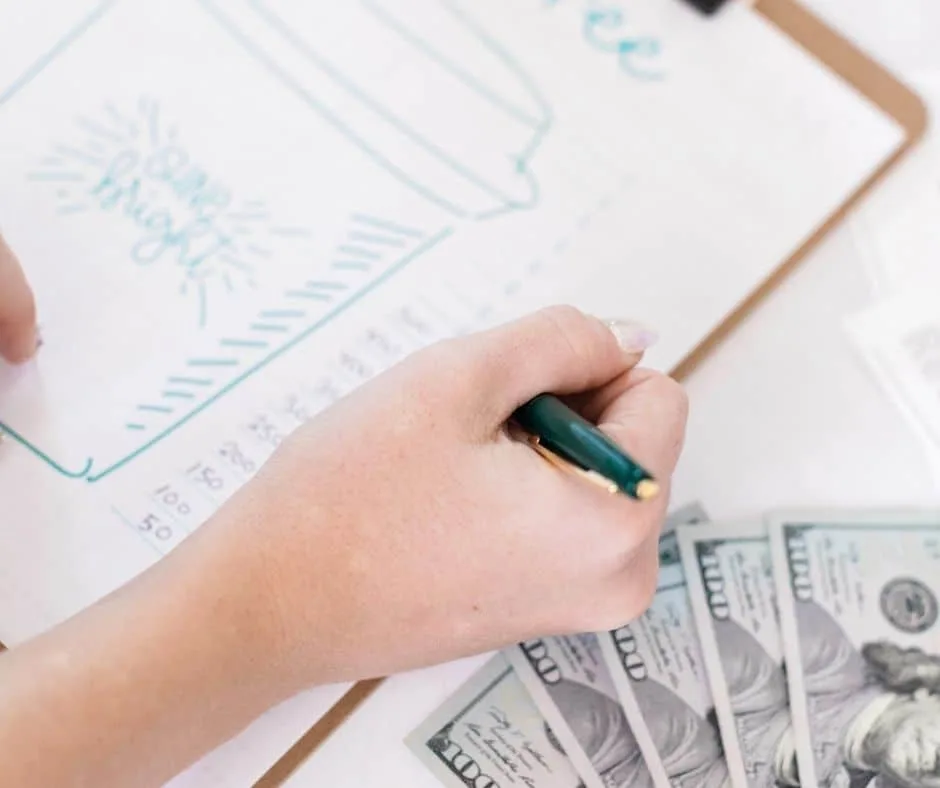Tired of spending too much money? I’m going to show you how to spend less money this year than you did last year. Buckle up.
You’re looking for quick ways to spend less money this year than last year, and I want to commend you.
Why?
Because it means you care about making your financial life better, and you've already taken the first step to do so (I mean, you’re here, right?).

I'm going to help guide you through how to:
- Understand how much is “too much” when it comes to spending your money
- Get past your personal batch of bad spending habits
- Use some new tricks to spend as little money as possible
But before we get ahead of ourselves, let’s talk about how you’ll know whether or not you spend less this year than last year.
We’ll call it calculating your spending benchmark.
How to Spend Less Money than You Did Last Year


This is a guide on ways to spend less with links to in-depth resources for further help on each of the strategies I discuss.
I HIGHLY recommend you click and go through each one.
But if I had to share just three ways to spend less money?
I'd share these:
- Decrease the Number of Times You're in a Store: Grocery shopping every other week instead of weekly will decrease your food bill (without having to use coupons). In fact, decreasing the number of times you enter a store, in general, will guarantee you spend less this year than last year. Not to mention, makes you fall for less sneaky supermarket tricks.
- Audit One Habit at a Time: Trying to change all of your habits at once is a recipe for misery. Instead, just take one habit at a time and figure out how to get what you WANT, while spending less on it.
- Trade Time for Services You Need: For example, you can mystery shop your oil changes to get them for free (I did this for several years!).
The details for each of these ideas, plus much more, are below.
But before we dive into the strategies, you’ve got to calculate your benchmark so that you know when you’re spending less than last year, and when you’re not.
Figure Out Your Benchmark – How Much Did You Spend Last Year?
If you want to spend less than you did last year, then you first have to figure out how much you spent last year.
That’s your spending benchmark to beat.
To be honest, this is a step that most people don’t take. They don’t want to look at the numbers, or they don’t want to put in the work to look at it.
But trust me – it doesn’t have to be hard.
Here’s how to do this yourself:
- Spending Tool Roundup: Figure out your spending tools. Credit card? Debit card? Checks? Write each down on a sheet of paper.
- Filter Each Tool by the Whole Year: Go through each spending tool, and do an annual review to get a snapshot of the amount you spent for the year. For a bank account, you can usually search for “debits”, and then filter your search by the entire year from January 1st to December 31st.
- Add it Up: After you gather this info from each spending tool, then add it all up. This is your spending benchmark to beat for the next year.
For example, we spend through our debit card, through occasional checks, and sometimes on our credit card.
Psssst: You can learn more about our hybrid spending strategy between cash and credit cards here.
For our bank account (Chase), we would filter a search from January 1st through December 31st for the following types of transactions:
- All debit transactions
- ACH debit
- Bill payment
- Checks Under 2 Years
And for our credit card? They (Citibank) offer a spending summary area where you can change the data to filter through the last year.
One and done!
Hint: how you get this information for you might look a bit different than this because you’re at a different bank/have different credit cards. But the process should be the same.
Two people who are excellent at doing this are Katie and Cullen, who found themselves over $100,000 in debt and started dealing with it this past January.
They’ve documented their entire journey, but the video playlist I’d like to share (for some motivation) is one where they go back to add up all their spending from last year so that they can compare month-to-month to see the difference they’ve made.
It’s inspiring!
Now, let’s move on.
How to Spend Less Money on Everything
We’re going to go over the following:
- How to quickly conduct an annual spending audit (already did that, above!)
- How to spend less money on food
- How to spend less money on clothes
- How to train yourself to spend less money
- How to control your emotional spending triggers
- How to do a no-spend challenge to kickstart new spending habits
Going through each of these sections and taking action (yes – if you don’t take action, you won’t see results) will have you spending less on everything in your life.
Which means, more money in your pocket and in your bank account.
So, let’s get started!
How to Spend Less Money on Food

When people start looking into how to cut back spending per year overall, they generally gravitate first to “How can I spend less money on food?”
In fact, I once heard from a woman by email that she was spending close to $1,000/month at the grocery store for her family of 4.
So, what’s the average spent on groceries and food each month, and how can you beat that average?
Glad you asked.
The average household grocery bill is:
- Average Grocery Bill for 1: The average grocery bill for 1 person per month (an adult) is $275.50 (males between 19-50 years), and $241.13 (females between 19-50 years).
- Average Monthly Grocery Bill for 2: The average monthly grocery bill for 2 adults (19-50 years) is $568.28.
- Average Grocery Bill for Family of 3: The average grocery bill for a family of 3 (monthly) is, unfortunately, not specifically given. So, I've averaged the cost for two adults, plus one child, and it comes to $779.50.
- Average Grocery Bill for Family of 4: The average grocery bill for a family of 4 (monthly) is $823.40 (with kids aged 2-5 years) and $967.43 (kids aged 6-11).
How does your own grocery shopping bill stack up to these?
Don’t worry if either you’re spending way more – partly from falling for one of these 17 sneaky supermarket tricks – or you’re right there with them (but you just can’t afford to spend that much, anyway).
I’ve written a ton about how to save money at the grocery store (and on eating, in general), and I’m going to link to all of those articles. But I want to leave you with my TOP TIPS for spending less on food each month (in case you don’t want to go rooting around my blog).
Top Ways to Spend Less Money on Food
#1: Audit One Food Habit at a Time
I outline in this daily frugal habits article how I audited just one of my food spending habits, and that saved us an astounding $800 over the last 8 months. Can you guess what it was? My breakfast (i.e., Starbucks drive-thru).
Spoiler alert: I got over it by creating my own pre-made barista ingredients at home once a week (with the help of my husband), plus Costco. It’s way healthier than what I was ordering at Starbucks, tastier, and costs wayyyyy less.
#2: Buy in Bulk…but with a Twist
I have a small family – just three of us (well…and our cat) – so I thought buying in bulk wouldn’t be a good deal for us.
BUT, it is. Well…with one twist: dole out the product in the same amount as if you didn’t buy in bulk.
Let me explain.
I found that when we bought things in bulk that we really like, and that wouldn’t expire before we could use it, we would USE MORE OF IT.
This was really frustrating to me. Here I was, trying to save money by buying in bulk (and it was easy to do – just buy the product), but we were actually spending more because our consumption pattern increased.
THEN, I came up with the idea to simply refill the old container with the 1-week amount we were using before. And when that’s out? It’s out, until the next grocery shopping trip.
Of course, we don’t do this with gross things, like meat. But I’ll give you two examples of where this has really helped:
- Cokes: My husband has quite the love of Cokes. But if I bought one of those huge Costco-cased sizes? I found he was drinking twice as much as normal. Gah! Instead, I buy the bulk-sized one, keep it in the garage, and simply fill up the refrigerator-sized package (12 cans) once a week after getting back from grocery shopping. When that’s done, it’s done (until my next grocery shopping trip).
- Applesauce Food Pouches: My son would eat three of these a day if I let him. Instead, I buy the bulk-sized one, then refill the 12-pack in the fridge (at his height so that he can help himself throughout the day) once a week when I go grocery shopping. The rest? They’re stored in the garage.
#3: Shop Every Other Week
You need to stay out of the store and make more use of what you have on hand (here are 17 cheap pantry meals from ingredients you probably already have).
My husband and I find that grocery shopping every other week has cut back our food bill by $150-$200/month.
Here's a link to our 2-week meal plan on a budget, with a grocery list.
#4: Replace Eating Out with Convenience Meals at Home
You can still get convenience in your life by using tools like Crockpots that can cook your food for you while you're at work and doing a freezer meal cooking day once a month or so to stock your freezer up for healthy TV dinners.
I dedicated an entire article on how to stop eating out so much. And you don’t have to miss all of your restaurant favorites – learn some top-secret copycat recipes.
There’s loads more info you can binge-read through on how to save money on food, how to avoid supermarket grocery tricks, and how to save money on groceries.
How to Spend as Little Money as Possible – Change Your Thinking
How do you spend very little money?
If you’re trying to spend as little money as possible, then you’ve got to change your thinking angle on everything.
Flip your thinking so that you’re wondering all month long how you can KEEP the most amount of your paycheck, possible.
Play for keeps, my friend.
Follow that thought process by creating your bare-bones budget, so that you can see what's possible when you just cover basic needs in your life.
In my Cutting Expenses to the Bone article, I share what a bare-bones budget looks like. Then, you get 49 “cuts”, or ways to get down to just the bare necessities.
Three example cuts that will help you to spend as little money as possible:
- Get rid of your second car (yes, my husband and I were a one-car family for 2.5 years after a hurricane flooded our second one)
- Shop around for new insurance quotes every six months (I’ve included how we switched companies and saved an insane $1600 one year)
- Mystery shop your oil changes (I did this to score free oil changes for several years)
Pssst: are you a student? I’ve got an article on the benefits of saving money for students and how to save money for students you might want to check out.
How Can I Train Myself to Spend Less Money?

Did you know that you can actually train yourself to spend less?
I wrote an entire article on how to train yourself to spend less money.
Let me sum up a few important points here:
- Track the number of stores you enter in a week, and then cut that by half
- Use a gift-card allowance system to buy things for yourself
- Stop the snowball spending effect by limiting the number of “extras” off your list that you’re allowed to put into your cart (like, 2)
- Do a No-Spend Challenge or a Frugal January, using one of these printable no-spend trackers
Psst: and if all else fails? You can always just hide money from yourself.
How to Spend Less Money and Save More
Once you get your spending under control, a crazy thing happens…you start noticing a buffer in your checking account.
Suddenly, you're not juggling to make ends meet at the end of the month or in between paychecks.
Your bills are being paid without any drama, and you have a surplus!
BANK the surplus. This is how you save money.
Start by setting up small automatic withdrawals from your paycheck or from your checking account once or twice a month that go straight to your savings account.
Then, as you get better and better about not spending all your money, increase those automatic withdrawal amounts.
You'll find LOADS more information on how to save money here.
And just so we drive this home even more, the way you spend less and save more is:
- Widening the Gap: Use the tips throughout this article on ways to spend less so that you can widen the gap between what you earn and what you have to spend to live comfortably.
- Banking the Difference: This one is important – and overlooked. You actually have to start banking the leftover money. Otherwise…it’ll get eaten up by what I like to call the “checking account gremlins.” Be intentional with this by upping your automatic withdrawal into savings as you work through cutting your expenses down. Slowly cut off the flow of money going towards spending, and expand the flow of money into your savings account.
Hint: where you can skyrocket your savings growth this year? Is if you can make more AND spend less money at the same time. That would really widen the gap between what you earn and what you need to spend, and that “gap” is what you can put into savings each month.
How to Spend Less Money on Clothes

Let’s face it: we all want to look good…but we don’t want to drop a small fortune on trendy clothes that will likely be out a few seasons from now (or our kids will drop ketchup on them and voila, they’re stained for life).
Hint: this is the category where I suffer the most buyer's remorse from. That's why I'm so excited I took control of it!
Because I believe wearing clothes that fit and that look great can truly make us FEEL great, I’ve got a few suggestions for you.
#1: Take some free, style mini-courses
My eyes were opened about a year ago when I found several free mini-courses that showed me how to reuse my own clothes to change my style.
By going through these steps, not only did I start to love the clothes I owned again, but I actually had a specific, small list of items to purchase that would turn my wardrobe into something trendy AND lasting.
It was wonderful!
Find out all the details in my article on how to change your style on a budget (you won’t be sorry).
#2: Source awesome, used clothing
Remember how I said I had a small list of items I needed once I went through those mini-courses?
Well, I didn’t go out and buy them brand new (at least not all of them). Rather, I found some ways to buy them used.
One of my favorite online thrift stores – so that you can shop used from home – is ThredUp.com. You should try them out!
#3: Build a capsule wardrobe
Those mini-courses will help you with this. For now, just know that a capsule wardrobe is KEY to keeping your clothing costs down – for everyone in your family.
Understand Your Psychological Reasons for Overspending

Do you spend money to make you feel better? Or because you think there’s a great bargain to be had and you have some FOMO (fear of missing out) rushing into your system?
Actually, there are many psychological reasons for overspending money.
They include:
- Our Brains Find it Pleasurable: Spending money releases a hit of dopamine to your system, which is pleasurable (and semi-intoxicating).
- We Think It’ll Fix an Emotional Problem: You have an emotional need or “emotional thirst”, as I like to call it, and you’re trying to fulfill that with empty marketing promises.
- We Think We’re Missing Out: Everyone has their own variety of FOMO (Fear of Missing Out). Mine happens to be on information – which is why I take so many courses and read so many books! Yours might be with owning what others have, or experiencing what others experience, regardless of the price.
Mark my words: products cannot fulfill emotional needs.
Learn about that, and much more, in my entire article on spending money to make you feel better. You’ll get a rundown of many psychological reasons for overspending.
Hint: lots of people have FOMO (Fear of Missing Out) on spending with friends. That's why I came up with 74 things to do with friends without spending money.
How to Stay Home and Not Spend Money
My grandfather – who was a young boy in the Great Depression – harped on my family about this for years. He would always tell us to stay home and stop spending our money.
And I hate to say it…but he’s kinda right.
Now, granted, there’s the internet and all so you can technically spend to your heart’s delight while still staying home.
My article on how to stop spending money online will help you with this, tremendously.
BUT, if you stay home more often, you’ll have far fewer spending opportunities.
Think about it: how many of us suddenly found ourselves spending wayyyyy less money during the shutdowns we all endured? It was mainly because we were home, using up our own resources, reflecting on our lives, and trying to survive RATHER than being “out there” and seeing stuff we suddenly needed to have.
Psst: no need to be bored when you stay at home. Here's 37 things to do when you're bored, broke, and alone.
Your Challenge: Another way I like to practically implement this? Is by counting the number of stores I go into on a weekly or daily basis.
You should try it out – instead of tracking your spending using something like a daily spending log, take one month to track the number of stores you enter.
That is telling, in and of itself.
And if you can then cut down on the number of times you set foot into a store (by batch-running errands, only going to the necessary ones, etc.)? Then you’ll undoubtedly spend less money this year than last.
There are two ways to save more money: spend less of it and earn more of it. This guide focuses on how to spend less money so that you can save more of it. Because at the end of the day: how much you earn may be out of your immediate control. But how much do you spend? Is very much IN your immediate control.
Amanda L Grossman
Latest posts by Amanda L Grossman (see all)
- 5 Surprising Ways to Cut Household Costs (Saved us over $1,412!) - March 11, 2024
- The No Spend Challenge Guide (Money Game-Changing Tool) - January 31, 2024
- 47 Seasonal Jobs in Alaska with Housing (Hiring for this Summer) - December 1, 2023

Amanda L. Grossman
Wednesday 28th of July 2010
Hello Brady!
That is neat--I played around with studying psychology because I love to study people and I find the brain fascinating:).
Brady Bryant
Tuesday 27th of July 2010
i am a b.s. pyschology student myself and i love pyschology because we are studying the behavior of humans.`-,
Amanda L. Grossman
Thursday 1st of July 2010
Hehehehe-Kim thanks for sharing! I guess you could sew it too....but that is WAY too far gone then:).
Kim
Wednesday 30th of June 2010
I knew I had gone too far with the poverty mind set the other day when....
I had gone to a garage sale and bought a light blue full size flat sheet. My 21 year old son happened to be in the car with me when I couldn't pass by the garage sale.
I got the sheet home and washed and dried it and asked my son to help me fold it. Once we held it out to fold, I realized there was a large tear in it. I got really upset and declared that I had been ripped off. My son reminded me that I had only spent 10 cents on it and that I would probably use the good part of the sheet to make pillow cases so I could hardly say I was ripped off.
That was going way too far with the poverty thing.
CentralNC
Tuesday 6th of April 2010
Being frugal is a financial mind game. If you are successful with your frugality and also have a productive career, you will eventually have enough resources to make you wonder if you're going too far with your frugality. Every once in a while, I do "reality checks" - comparing current resources & goals vs. my standard of living, then making adjustments as needed. We're not here forever, your frugality should be a means to an end, a time-bound end to be exact. You should have a plan & timeline for all that money that you're saving away. Your definition of "frugal decadence" on this page says it all: life is too short to deny yourself and too long to spend it all today.